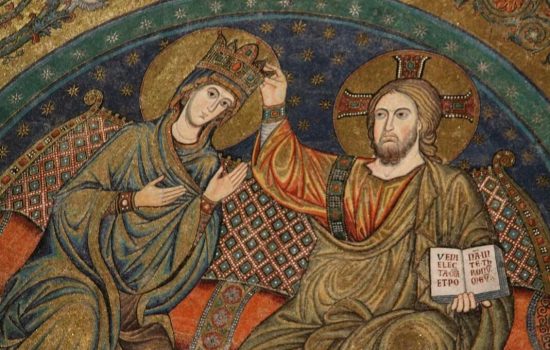May, the Month of Mary
For many Catholics the month of May is seen as the Month of Mary, and we all get the same question from time to time: Why is May Mary’s month? For centuries, the Catholic Church has set aside the entire month of May to honor Mary, Mother of God. Not just a day in May, mind you, but the entire month.
The custom spans both centuries and cultures, with roots going back as far as the Ancient Greeks. In early Greece, May was dedicated to Artemis, the goddess of fecundity. In Ancient Rome, May was dedicated to Flora, the goddess of blooms, or blossoms. In medieval times, similar customs abounded, all centering around the practice of expelling winter, as May 1 was considered the start of new growth. During this period, the tradition of Tricesimum, or “Thirty-Day Devotion to Mary,” came into being. Also called, “Lady Month,” the event was held from August 15-September 14 and is still observed in some areas.
The idea of a month dedicated specifically to Mary can be traced back to baroque times. Although it wasn’t always held during May, Mary Month included thirty daily spiritual exercises honoring Mary. It was in this era that Mary’s Month and May were combined, making May the Month of Mary with special devotions organized on each day throughout the month. This custom became especially widespread during the nineteenth century and remains in practice until today.
The ways Mary is honored in May is as varied as the people who honor her. It’s common for parishes have a daily recitation of the Rosary during May, and many erect a special May altar with a statue or picture of Mary as a reminder of Mary’s month. Additionally, it’s a long-standing tradition to crown the statue of Mary during May – a custom known as May Crowning.
But May altars and crownings aren’t just “church” things. We can and should be doing the same in our homes. When we echo the customs and traditions of the Church in our homes – our domestic churches – we participate more fully in the life of the Church. For May, give Mary a special spot in your prayer corner. It can be a statue or picture, but place there some representation of our Blessed Mother. Make it appealing and a real tribute to her beauty and virtue.
Then, crown Mary. You can give her an actual or spiritual crown and you can make it a subtle gesture or ornate ceremony of your own device. The meaning is far more important than the action. You can do it in the beginning, at the end of May or anywhere in between.
Just do it. Why? Not because it’s a long-standing tradition in the Church, although it is. Not because there are any special graces connected to it, although there is. No, do it because Mary is Mother – your mother, my mother, everyone’s mother – and because she cares for all of us day-in-and-day-out without fail, interceding for us in even the tiniest matters. For that, she deserves an entire month in her honor.
Mayo, Mes de María
Ya estamos en mayo, el mes dedicado desde tiempo inmemorial a la Virgen María. La costumbre nació en la antigua Grecia. El mes mayo era dedicado a Artemisa, la diosa de la fecundidad. Algo similar sucedía en la antigua Roma pues mayo era dedicado a Flora, la diosa de la vegetación. En aquella época celebraban los ludi florals o los juegos florales a finales de abril y pedían su intercesión. En la época medieval abundaron costumbres similares, todo centrado en la llegada del buen tiempo y el alejamiento del invierno. El 1 de mayo era considerado como el apogeo de la primavera.
Y en España el origen de la celebración está en la devoción y creatividad del Rey de Castilla, Alfonso X el Sabio, quien en sus famosas “Cantigas a la Virgen María”, del Siglo XIII, hay una llamada “Mayo”. El mismo Rey Alfonso escribe en las “cantigas” que hay que “trovar en honor de la Rosa de las Rosas y de la Flor de las flores”. Y aquí encontramos ya el mensaje florido de la celebración que, también, con la Pascua florida, con la Resurrección del Señor. No se olvide que la Pascua se celebra asimismo en mayo.
Durante este período, antes del siglo XII, entró en vigor la tradición de Tricesimum o “La devoción de treinta días a María”. Estas celebraciones se llevaban a cabo del 15 de agosto al 14 de septiembre y todavía puede observarse en algunas áreas.
La idea de un mes dedicado específicamente a María se remonta al tiempo barroco o siglo XVII. Si bien, no siempre se llevó a cabo en mayo, el mes de María incluía treinta ejercicios espirituales diarios en honor a la Madre de Dios. Fue en esta época que el mes de mayo y de María se combinaron, haciendo que esta celebración cuente con devociones especiales organizadas cada día durante todo el mes. Esta costumbre se extendió sobre todo durante el siglo XIX y se practica hasta hoy.
Las formas en que María es honrada en mayo son tan variadas como las personas que la honran. Es común que las parroquias tengan en mayo un rezo diario del Rosario y muchas erijan un altar especial con una estatua o imagen de María. Además, se trata de una larga tradición el coronar su estatua, una costumbre conocida como la Coronación de Mayo. Los altares y coronaciones en este mes no son solo privilegios de la parroquia. En los hogares también se puede participar plenamente coronando el cuadro familiar o la imagen de la virgen que tengan en casa.
La devoción a María en mayo, en el mes de las flores, se ha convertido en algo muy entrañable y que los niños, en su Primera Comunión, tienen muy presente. Y ese origen infantil permanece en el corazón de los adultos. El culto pues a la Madre de Jesús toma especiales brillos durante este mes de mayo, de muchas formas y es muy habitual que al final de las Eucaristías diarias de mayo haya un recuerdo en forma de cantos o de un texto adecuado para María Virgen. Dispongámonos todos, a rezar con y para María, para que su potente intercesión nos haga alcanzar todo los que el Señor Jesús nos ha prometido.















